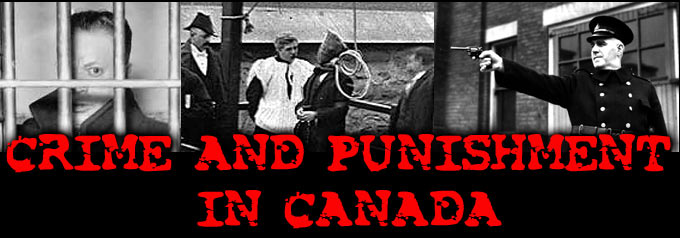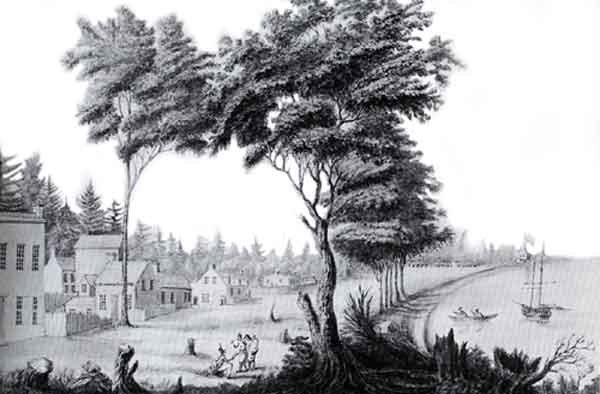
|
CONSTABULARY POLICING IN
YORK UPPER CANADA |
| PREVIOUS PAGE NEXT PAGE |
|
POLICE IN YORK TOWN (TORONTO ONTARIO) UPPER CANADA 1793 - 1834
Toronto
as it appeared in the autumn of 1803 The
early court records of York Town, later to become Toronto, were destroyed by
a flood of water from a broken pipe during the 1930s.[1]
One of the few sources we have as to what they might have contained
is a study based on some of those records prior to their destruction by a
Toronto magistrate, James Edmund Jones, published in 1924.[2]
According
to Jones, Upper Canada authorities were having problems in compelling their
citizens to function as Constables to the extent that they were imprisoning
violators:
The
situation became so desperate that in 1823 the Magistrates directed that
every innkeeper throughout Upper Canada be appointed a constable. This
regulation remained in force in rural Ontario until 1887.[6]
The
number of constables is extraordinary in terms of a constable to population
ratio. If we take the 1830
figure, after its reduction of constables, there is still a highly
over-policed ratio of one constable for every 241 inhabitants.
(Toronto’s population stood at 2,900 in 1830.)[12]
In 1823, with York’s population estimated at 1,500, the twenty
constables would give a ratio of one for every 75 citizens.[13]
Much later in the mid-nineteenth century, the Toronto Police Board
would argue that a ratio of one police officer for every 800 inhabitants was
desired for the maintenance of order in Toronto and kept near to that figure
in staffing the department.[14]
Today, by comparison, there is approximately one uniformed officer
for every 475 Torontonians.[15] It
is difficult to assess why there was such a high ratio of constables to
inhabitants in York but it would have had to do with issues other than a
high crime rate, the presence of which there is no evidence for.
While there are no precise crime statistics for York itself, in Upper
Canada overall between 1790-1835 there were a total of 1,106 criminal
sentences handed down in Criminal Assizes, of which more than ten percent
were death sentences (138.)[16]
(The population of Upper Canada was 60,000 in 1812.)[17]
But this high rate of capital punishment has more to do with the fact
that the death penalty was the punishment for no less than 120 different
crimes, then with a high rate of serious crime.[18]
(It would be only in 1833 when the death penalty was restricted to twelve
offences, and 1841 finally to only murder and treason.[19])
Furthermore, there were no penitentiaries in which to confine
convicts for any extended period of time until Kingston opened its doors in
1830. The statistics therefore,
do not suggest a particularly high rate of criminal offenses.
A study by John Beattie at Toronto’s Center of Criminology also
confirms this and in addition, finds that there was no perception of
a threat from crime either.[20]
Later in this study, we will further explore the issue of crime and
policing in the latter part of the nineteenth century. One
has to also bear in mind that the relationship between crime and the police
was not as direct as it is today, especially in the non-urbanized Upper
Canada. The police were not
ostensibly “crime-fighters.” Constables served various civic functions
such as enforcement of produce and meat market regulations, livestock and
animal control, tavern licensing, regulation of carters, health and fire
safety. They would have served
the surrounding country as well. Furthermore,
they were not trained or full time professionals and as they were
conscripted, the authorities, as bureaucracies do whenever they can, perhaps
over staffed the strength of the York constabulary. PREVIOUS PAGE NEXT PAGE: HISTORY OF THE TORONTO POLICE 1834 - 1850 NEXT PAGE |
|
SOURCES
[1] Jack Choules, Archivist, Justice Records Portfolio, Archives of Ontario – statement to writer, Toronto, 1994. [2] Jones, James Edmund, Pioneer Crimes and Punishments in Toronto and the Home District, Toronto: 1924. [3]
Ibid p. 152. [4] Ibid p 153. [5] Ibid p. 151. [6] Ibid p. 169. [7] Ibid p. 107. [8] Ibid p. 152 [9] Ibid p. 169 [10] Ibid p. 153 [11] Jones, p. 153 [12] Law Society of Upper Canada, Chronology, ; http://www.lsuc.on.ca/about/about_historical_en.jsp [13] York Population in 1820: 1,240; in 1825: 1,677. Firth, Edith (ed) The Town of York 1793-1834: A Further Collection of Documents of Early Toronto, Toronto: The Champlain Society, 1966. p. ixxxii [14] Toronto City Council Minutes 1859, Report of the Board of Police Commissioners, February 1, 1859. [15] Toronto Police Service, Annual
Report 1998, Statistical Report, Table 98, Toronto: 1999. [16] See Table in: Oliver, Peter, Terror to Evil-Doers: Prisons and Punishments in Nineteenth-Century Ontario, Toronto: University of Toronto Press, 1998. pp. 14-15. [17] Ibid p. xxii. [18] Jones, pg 1. [19] Beatie, J.M. Attitudes Towards Crime and Punishment in Upper Canada, 1830-1850, Toronto: Center of Criminology, University of Toronto, 1977. p. 10 [20] Ibid pp. 37-39
|
|
PREVIOUS PAGE NEXT PAGE: HISTORY OF THE TORONTO POLICE 1834 - 1850 NEXT PAGE |
|
CRIME
& PUNISHMENT IN CANADA: |
|
|

 In
1826, the first police office was opened in Toronto, with limited office
hours of 11 a.m. to 2 p.m., except Sunday, Christmas Day and Good Friday.
In
1826, the first police office was opened in Toronto, with limited office
hours of 11 a.m. to 2 p.m., except Sunday, Christmas Day and Good Friday.